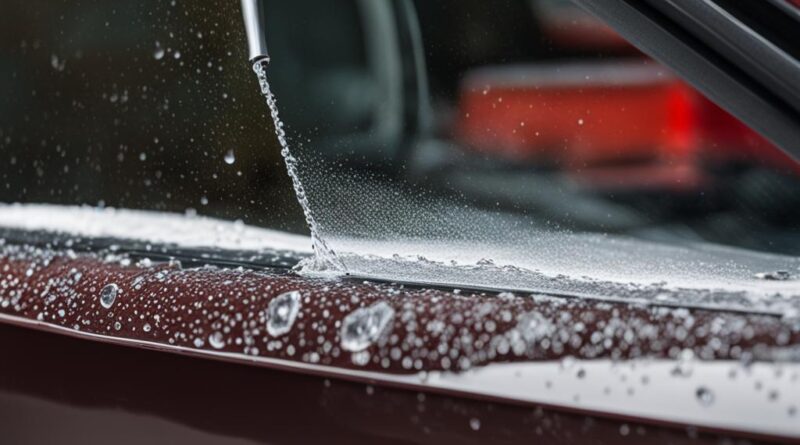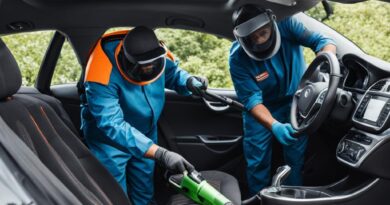Car Seal Protection & Maintenance Guide for Vehicles
Welcome to our comprehensive guide on car seal protection and maintenance. In this article, we will provide you with valuable information on how to keep your vehicle’s seals in top condition, ensuring optimal performance and longevity. Whether you’re a seasoned car enthusiast or a first-time car owner, these tips and techniques will help you protect your automobile seals and maintain the beauty of your vehicle.
Car seals play a vital role in protecting your vehicle’s exterior from the harsh elements of the environment. From UV rays to dust and grime, car seals act as a barrier, shielding your paint and bodywork from potential damage. By properly sealing your vehicle, you can not only enhance its appearance but also prevent unnecessary wear and tear.
Car sealants are the go-to solution for car owners looking to provide long-lasting protection and enhance their vehicle’s shine. These synthetic products are designed to shield your car’s paint while providing a glossy finish. Whether you’re looking for a quick and easy sealant or a professional-grade solution, there are various options available in the market to suit your specific needs.
Key Takeaways:
- Car sealants protect your vehicle’s paint from UV rays and environmental elements.
- There are different types of sealants, including acrylic and polymer.
- Popular car sealants include Nexgen Ceramic Coating Spray and Meguiar’s Mirror Glaze Synthetic Sealant.
- When choosing a sealant, consider factors such as your vehicle’s material, budget, and specific objectives.
- Regular car maintenance, including washing and waxing, is essential for protecting and prolonging the life of your car seals.
What Is Car Sealant?
Car sealant, also known as car paint sealant, is a synthetic product that protects a vehicle’s exterior and paint from UV rays, heat, and acid rain. It provides a glossy shine, protects the paint from contaminants, and requires minimal maintenance. Car sealant is designed to be easy to use and can last between six months to a year, offering long-lasting protection for your car’s paint. It forms a protective barrier that makes the car resistant to fading or peeling, helping to lower maintenance costs in the long run.
When applied correctly, car sealant enhances the appearance of your vehicle, leaving behind a smooth, glossy finish that gives your car a showroom-worthy shine. Additionally, the sealant acts as a shield against environmental factors like harmful UV rays, which can cause the paint to fade and deteriorate over time. By preventing the paint from oxidizing, car sealant extends the life of your car’s exterior, keeping it looking new and vibrant for longer.
One of the key advantages of car sealant is its high resistance to contaminants. It creates a protective layer that repels water, dirt, grime, and other pollutants that can adhere to the surface of your car’s paint. This means that when you wash your car, these contaminants are easier to remove, saving you time and effort in the cleaning process.
Car sealant provides a range of benefits, including:
- Long-lasting protection against UV rays, heat, and acid rain
- A glossy shine that enhances the appearance of your car
- Protection against fading, peeling, and other paint damage
- Easy application and minimal maintenance
- Resistance to contaminants for a cleaner, easier-to-maintain car
Types of Sealants for Cars
When it comes to protecting your car’s exterior, there are various types of sealants to choose from. Two common options are acrylic sealants and polymer sealants. Let’s take a closer look at each:
Acrylic Sealant
Acrylic sealants are popular for their ability to provide a glossy finish to your car’s paint. They are easy to apply and can give your vehicle a smooth and lustrous appearance. These sealants offer a layer of protection against UV rays, moisture, and other environmental elements that can damage the paint. Meguiar’s Mirror Glaze Synthetic Sealant is a well-known acrylic sealant that provides excellent shine and durability.
Polymer Sealant
For longer-lasting protection, polymer sealants are a great choice. These sealants are specially formulated to offer resistance against scratches, swirls, and high temperatures. They create a protective barrier on the paint, preventing contaminants from causing damage. Polymer sealants, such as CARPRO Reload Spray Sealant, provide a durable shield against the elements, enhancing the longevity of your car’s appearance.
Here’s a comparison of the two sealants:
| Sealant Type | Key Features | Popular Brand |
|---|---|---|
| Acrylic Sealant | Glossy finish, easy application | Meguiar’s Mirror Glaze Synthetic Sealant |
| Polymer Sealant | Long-lasting protection, resistance to scratches and swirls | CARPRO Reload Spray Sealant |
Other sealants worth considering include the Nexgen Ceramic Coating Spray, which offers exceptional shine and durability, and the Chemical Guys JetSeal Paint Sealant, known for its longevity and protection against environmental elements.
Choosing the right sealant depends on your preferences and the level of protection you desire for your car. Whether you opt for the glossy finish of an acrylic sealant or the long-lasting durability of a polymer sealant, applying a high-quality sealant will help keep your car looking its best.
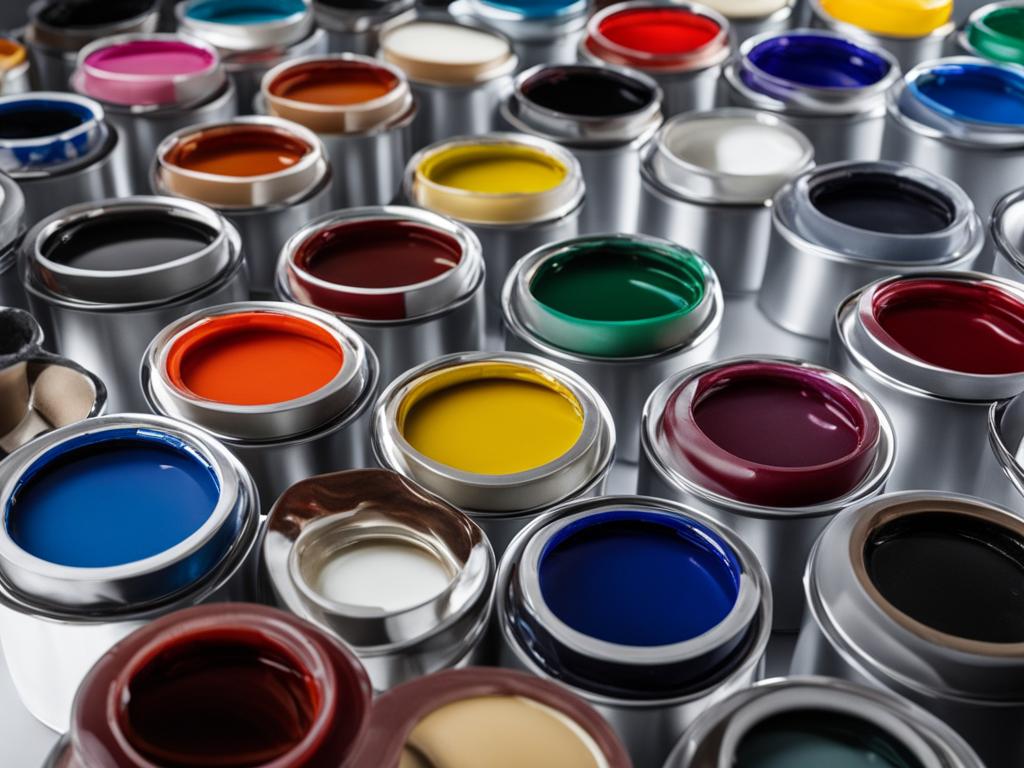
How to Choose a Sealant for Your Car
When it comes to selecting a sealant for your car, there are a few key factors to consider: the vehicle material, budget, and your specific objective.
First and foremost, the material of your vehicle plays a crucial role in determining the type of sealant that will provide the best protection. Some sealants are specifically formulated to work better on certain materials, such as paint, plastic, or metal. For example, if your car has a clear coat finish, you may opt for a sealant that is designed to enhance the shine and protect the clear coat layer.
Secondly, your budget is an important consideration. Sealants come in a wide range of prices, so it’s essential to determine how much you are willing to invest in your car’s protection. Keep in mind that higher-priced sealants often offer advanced features and durability, but there are also budget-friendly options available that can still provide decent protection.
Lastly, identifying your specific objective is crucial in selecting the right sealant. Do you want to prioritize protection against rain, UV light, or environmental contaminants? Are you looking to enhance the glossiness of your car’s paint? Understanding your objective will help you narrow down your choices and find a sealant that suits your needs.
It’s also worth mentioning that reading the ingredient list and manufacturer’s recommendations is vital. This information can give you insight into the performance, durability, and application process of the sealant. Following the manufacturer’s instructions ensures that you achieve optimal results.
Choosing the Right Sealant: A Comparison Chart
| Sealant | Vehicle Material | Budget | Objective |
|---|---|---|---|
| Nexgen Ceramic Coating Spray | All materials | Mid-range | Enhanced glossiness and long-lasting protection |
| Meguiar’s Mirror Glaze Synthetic Sealant | All materials | Budget-friendly | Protection against UV light and environmental contaminants |
| CARPRO Reload Spray Sealant | All materials | High-end | Hydrophobic properties and long-lasting durability |
| Chemical Guys JetSeal Anti-Corrosion Sealant | All materials | High-end | Protection against scratches and swirl marks |
Preventative Tasks for Car Maintenance
Regular car maintenance is essential for ensuring optimal vehicle performance and increasing its lifespan. By performing preventative tasks on a routine basis, you can proactively address potential issues, minimize wear and tear, and avoid costly repairs. Here are some key preventative tasks that every car owner should prioritize:
Oil and Coolant Levels
Regularly checking and maintaining proper oil and coolant levels is crucial for the smooth operation of your vehicle’s engine. Low oil levels can lead to increased friction and damage, while insufficient coolant can result in overheating. Refer to your car’s manual to determine the recommended oil and coolant levels and top up accordingly.
Air Filter Inspection
The air filter plays a vital role in preventing contaminants from entering the engine. A clogged air filter can hinder airflow, reduce fuel efficiency, and impact engine performance. Regularly inspect the air filter and replace it if it appears dirty or clogged.
Tire Pressure and Tread Depth Monitoring
Maintaining proper tire pressure is crucial for safety, handling, and fuel efficiency. Use a tire pressure gauge to check the pressure regularly, and inflate or deflate the tires as needed. Additionally, keep an eye on the tread depth to ensure adequate traction and replace tires that are worn out.
Light Functionality
Ensure that all lights, including headlights, turn signals, brake lights, and taillights, are functioning properly. This not only enhances your safety on the road but also ensures that other drivers can see your vehicle clearly.
Oil and Filter Change
Regularly changing the engine oil and filter is one of the fundamental preventative tasks for car maintenance. Oil breaks down over time and loses its ability to lubricate effectively, while a clogged filter can restrict oil flow. Consult your vehicle’s manual for recommended intervals and guidelines.
Tire Rotation
Rotating your tires at regular intervals helps distribute wear evenly across all four tires, extending their lifespan. This is particularly important with front-wheel drive vehicles, as the front tires tend to wear out faster than the rear ones. Follow the recommended rotation pattern outlined in your car’s manual.
Cleaning and Waxing
Regularly washing and waxing your vehicle not only enhances its appearance but also protects the paint finish from UV rays, environmental contaminants, and corrosion. Clean the car’s exterior using a gentle automotive cleaner, and apply a high-quality wax to provide an additional layer of protection and shine.
Transmission Fluid Check
Monitoring the level and condition of your vehicle’s transmission fluid is crucial. Low or contaminated transmission fluid can result in shifting problems and potential damage to the transmission system. Refer to your car’s manual for instructions on how to check and maintain the appropriate fluid level.
Shocks and Struts Inspection
Inspecting the shocks and struts is important for maintaining a smooth and comfortable ride. Worn-out or damaged shocks and struts can compromise the vehicle’s stability, handling, and braking performance. If you notice signs of leaking, excessive bouncing, or uneven tire wear, have the shocks and struts inspected and replaced if necessary.
Coolant Fluid Exchange
Periodically exchanging the coolant fluid helps maintain the cooling system’s efficiency and prevent overheating. Over time, coolant can become contaminated or lose its effectiveness. Follow the guidelines provided by your vehicle’s manufacturer to determine the recommended coolant exchange intervals.
Spark Plug Check
Spark plugs play a crucial role in the ignition process, providing the necessary spark to ignite the air-fuel mixture in the engine. Worn or faulty spark plugs can lead to misfires, reduced fuel efficiency, and engine performance issues. Inspect the spark plugs regularly and replace them if necessary.
Serpentine Belt and Differentials Inspection
Inspecting the serpentine belt and differentials is important for ensuring proper engine function and power distribution. Cracked or worn serpentine belts can cause various issues, while neglected differentials can lead to drivability problems. Inspect these components periodically and have them replaced or serviced as needed.
By adhering to a car maintenance schedule and performing these preventative tasks, you can keep your vehicle in top condition and minimize the risk of unexpected breakdowns or costly repairs. Remember to maintain detailed records of your maintenance activities, including dates and mileage, to stay on top of your car’s upkeep.
| Preventative Task | Recommended Frequency |
|---|---|
| Checking oil and coolant levels | Every month |
| Inspecting the air filter | Every 6 months |
| Monitoring tire pressure and tread depth | Every month |
| Ensuring proper functioning of lights | Every 3 months |
| Changing oil and filters | Every 3,000 to 5,000 miles or as recommended by the vehicle manufacturer |
| Rotating tires | Every 6 months or as recommended by the tire manufacturer |
| Waxing the vehicle | Every 3 months |
| Checking transmission fluid | Every 30,000 to 60,000 miles or as recommended by the vehicle manufacturer |
| Inspecting shocks and struts | Every 12 months or as recommended by the vehicle manufacturer |
| Coolant fluid exchange | Every 2 to 5 years or as recommended by the vehicle manufacturer |
| Checking spark plugs | Every 30,000 to 100,000 miles or as recommended by the vehicle manufacturer |
| Inspecting the serpentine belt and differentials | Every 12 months or as recommended by the vehicle manufacturer |
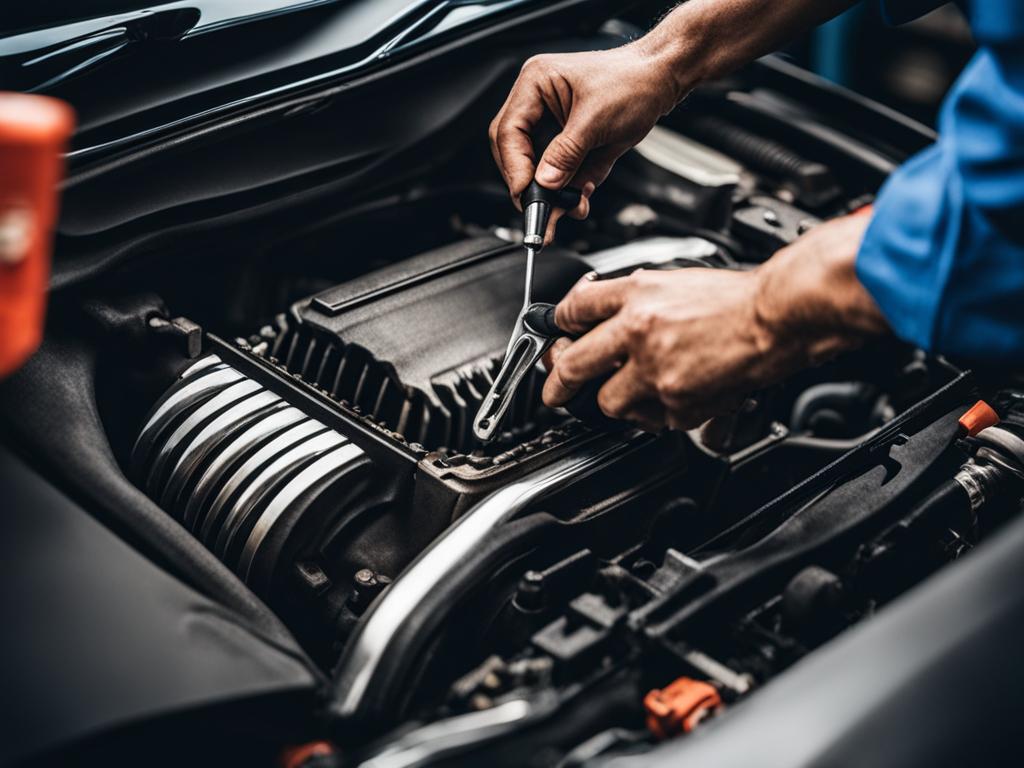
Short-Term Check-Ups for Car Maintenance
Proper short-term check-ups are essential for maintaining your car’s performance and preventing potential issues. By regularly performing these check-ups, you can ensure that your vehicle is in top condition and reduce the risk of costly repairs in the long run.
Recommended Short-Term Check-Ups:
- Oil and Coolant Levels: Regularly check the oil and coolant levels to ensure proper lubrication and engine cooling. Low levels can lead to engine damage and overheating.
- Air Filter: Inspect and clean or replace the air filter as necessary. A clogged air filter can reduce fuel efficiency and engine performance.
- Tire Pressure and Tread Depth: Monitor tire pressure using a gauge and maintain the recommended levels. Check the tread depth to ensure adequate traction and safety.
- Headlights and Lights: Verify that all headlights and lights are functioning properly. Replace any burnt-out bulbs to maintain visibility on the road.
- Oil and Filter: Regularly change the oil and filter according to the manufacturer’s recommendations. Clean oil and a new filter ensure optimal engine performance.
- Rotate Tires: Rotate your tires regularly to promote even wear and extend their lifespan. Consult your vehicle’s manual for the recommended rotation pattern.
- Wax Vehicle: Protect your car’s paint and reduce the chance of rust by waxing it regularly. The wax creates a barrier against environmental elements.
Performing these short-term check-ups at consistent intervals, such as every month or at least every few months, will help keep your car in excellent condition. Regular maintenance ensures that your vehicle operates safely and efficiently, saving you time and money in the long run.
Quotes:
Regular oil changes and tire rotations are vital for extending the life of your car and maximizing its fuel efficiency. Don’t skip these short-term check-ups!
Monitoring your tire pressure and inspecting the tread depth can prevent uneven wear and potential blowouts. It’s a simple yet crucial short-term check-up.
Long-Term Check-Ups for Car Maintenance
In addition to short-term check-ups, long-term maintenance tasks are crucial for ensuring the proper functioning and longevity of your vehicle. These long-term check-ups involve various components and fluids that need regular inspection and maintenance.
Checking and Changing Transmission Fluid
Transmission fluid plays a vital role in the smooth operation of your vehicle’s transmission system. Over time, transmission fluid can become contaminated or break down, affecting the performance of your transmission. It’s important to periodically check the transmission fluid level and quality and replace it as necessary. This helps to prevent costly transmission issues and maintain optimal performance.
Inspecting Transfer Case Fluid
For four-wheel or all-wheel drive vehicles, the transfer case fluid is responsible for transferring power between the front and rear wheels. To ensure smooth operation and prevent damage to the transfer case, it’s essential to inspect the transfer case fluid regularly. Any signs of fluid degradation or contamination should prompt a fluid change by a qualified technician.
Inspecting Shocks and Struts
Shocks and struts play a critical role in maintaining a smooth and controlled ride. Over time, these components can wear down and lose their effectiveness, leading to poor handling and an uncomfortable driving experience. Regularly inspecting shocks and struts allows you to identify any signs of leakage, damage, or worn-out parts. If necessary, replace them to restore optimal vehicle performance and ride comfort.
Coolant Fluid Exchange
The coolant fluid, also known as antifreeze, is responsible for regulating the temperature of your engine and preventing overheating. Over time, coolant can become contaminated or lose its effectiveness, leading to potential engine damage. Regularly exchanging the coolant fluid helps maintain the engine’s operating temperature and prevents costly repairs due to overheating.
Checking and Replacing Spark Plugs
Spark plugs are responsible for igniting the fuel-air mixture in the engine cylinders, ensuring proper combustion and engine performance. Over time, spark plugs can wear out or become fouled, leading to misfires, reduced fuel efficiency, and engine performance issues. Regularly checking and replacing spark plugs according to the manufacturer’s recommendations helps maintain optimal engine performance and fuel efficiency.
Inspecting the Serpentine Belt
The serpentine belt is a crucial component that drives various engine accessories, such as the alternator, power steering pump, and air conditioning compressor. Over time, the serpentine belt can become worn, cracked, or loose, affecting the performance of these accessories. Regularly inspecting the serpentine belt allows you to identify any signs of damage or wear and address them promptly to avoid belt failure and subsequent accessory malfunctions.
Maintaining Front and Rear Differentials
Front and rear differentials are responsible for distributing power to the wheels and allowing them to rotate at different speeds when turning. Regular maintenance of these differentials involves inspecting the fluid level, checking for any leaks or contamination, and ensuring proper lubrication. This helps to prevent premature wear and damage to the differentials and ensures optimal performance.
Regularly performing these long-term check-ups and maintenance tasks will help keep your vehicle running smoothly, prevent costly repairs, and prolong its overall lifespan.

Seasonal Check-Ups for Car Maintenance
Regular check-ups and maintenance are crucial for keeping your car in optimal condition all year round. Seasonal changes bring different challenges for your vehicle, and it’s essential to address them to ensure your car’s safety and performance in varying weather conditions.
Replacing Windshield Wipers
Windshield wipers play a vital role in maintaining visibility during rain, snow, or sleet. Over time, wiper blades can become worn, cracked, or damaged, resulting in reduced effectiveness. Regularly inspect and replace your windshield wipers to ensure clear visibility and safe driving.
Battery Performance Check
Your car’s battery is especially vulnerable during extreme temperatures. Cold weather can weaken its performance, while hot weather can accelerate battery fluid evaporation. It’s important to have your battery tested to ensure optimal performance and prevent unexpected breakdowns.
Changing Tires
As the seasons change, so should your tires. Winter driving requires tires that provide superior traction on snow and ice, while summer driving requires tires that can handle high temperatures. Regularly evaluate your tires’ condition and consider changing to the appropriate type for the season to maintain grip and handling.
Checking Coolant Levels
Coolant, also known as antifreeze, is critical for regulating the engine’s temperature, especially during freezing temperatures. Proper levels of coolant prevent engine overheating and potential damage. Regularly check the coolant levels, ensuring they are adequate and the mixture is correct.
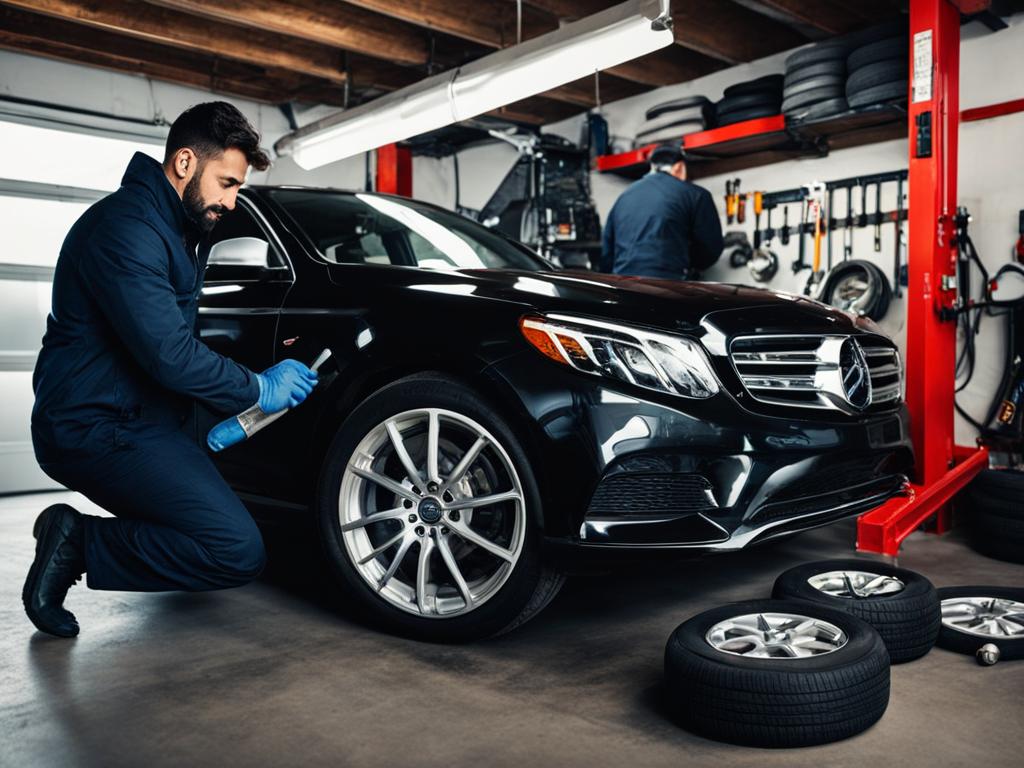
By performing these seasonal check-ups and addressing specific maintenance tasks, you can ensure your car is ready to face the challenges of each season. Remember, proactive care and attention to detail can go a long way in keeping your vehicle running smoothly and safely throughout the year.
Wash and Dry Regularly
Regularly washing and drying your car is essential to maintain its appearance and protect against damage caused by UV rays, dust, and grime. Follow this step-by-step guide to ensure a thorough and effective cleaning:
- Park your car in a shady spot to prevent the cleaner from drying too quickly.
- Start by rinsing the car with water to remove loose dirt and debris.
- Apply a gentle automotive cleaner to a sponge or mitt and lather the entire car, working from the top down.
- Rinse off the cleaner with water, ensuring that all soap residue is removed.
- Use a microfiber towel or soft cloth to dry the car, working in straight lines to avoid streaks.
- Pay attention to areas prone to water spots, such as windows and mirrors, and dry them thoroughly.
- To remove bird droppings or mud stains, gently clean the affected area with suitable products to avoid paint damage.
Regular washing and drying not only keeps your car looking its best but also helps to preserve the paint and protect against UV rays, which can cause fading and damage over time.
Polish with Wax
Polishing your car with wax is an important step in maintaining its shine and protecting it from environmental elements. Car wax not only improves the luster of the clear coating but also provides essential protection against UV rays, bird droppings, and bug splatters. Additionally, waxing your car can help reduce drag force, resulting in better aerodynamics and improved fuel efficiency.
Types of Wax
There are different types of car wax available on the market, each offering unique properties and benefits. Some common types of car wax include:
- Solid Paste Wax: This type of wax comes in a solid form and requires some effort to apply and remove. It provides excellent protection and gives a deep, high-gloss shine to your car’s paint.
- Liquid Wax: Liquid wax is easier to apply and remove compared to solid paste wax. It offers good protection and leaves a glossy finish on the paint surface.
- Synthetic Wax: Synthetic wax is formulated with advanced polymers and additives that enhance its durability and protection. It provides long-lasting shine and is resistant to harsh weather conditions.
- Spray Wax: Spray wax is the most convenient type of wax to use. It comes in a spray bottle, allowing for easy application and quick touch-ups.
When choosing a wax for your car, consider factors such as your desired level of protection, ease of application, and the specific needs of your vehicle.
How to Apply Wax
Follow these steps to apply wax to your car:
- Wash your car thoroughly to remove any dirt or grime.
- Dry the car using a microfiber towel or a soft cloth.
- Apply a small amount of wax onto a clean applicator pad or cloth.
- Spread the wax evenly on one section of the car’s paint, using circular motions.
- Allow the wax to dry to a haze.
- Buff the dried wax using a clean microfiber towel or cloth. Repeat the process for the rest of the car.
Regular waxing will not only keep your car looking its best but also protect it from the elements, ensuring that it retains its value over time.
Car Wax Comparison
| Product | Type | Protection | Shine | Durability |
|---|---|---|---|---|
| Nexgen Ceramic Coating Spray | Liquid Wax | High | High | Long-lasting |
| Meguiar’s Mirror Glaze Synthetic Sealant | Synthetic Wax | Medium | High | Durable |
| CARPRO Reload Spray Sealant | Spray Wax | Medium | Glossy | Long-lasting |
| Chemical Guys JetSeal Paint Sealant | Solid Paste Wax | High | Deep | Durable |
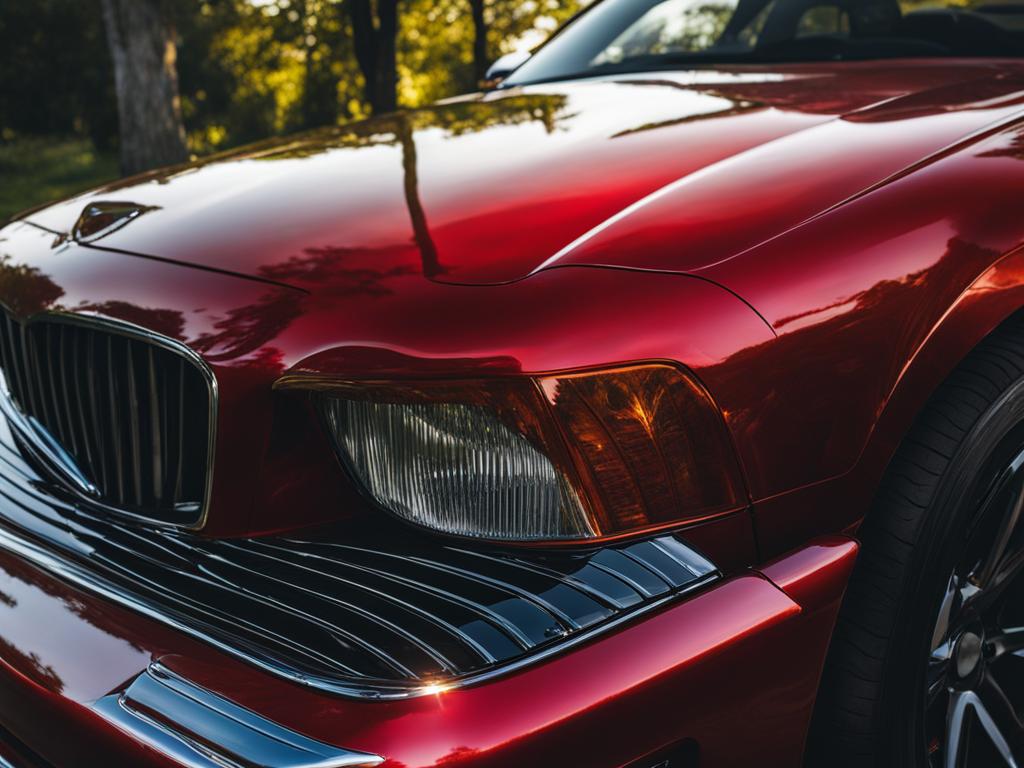
Use Paint Sealant
When it comes to protecting your car’s paint and achieving a glossy look, paint sealants are an excellent choice. Unlike car wax, paint sealants provide longer-lasting protection and are easy to use. They create a protective barrier that shields your vehicle from scratches and swirl marks, as well as environmental factors that can dull the paint over time.
Before applying a paint sealant, it’s important to do some prep work to ensure the best results. This may include washing and drying your car thoroughly, removing any contaminants or residues that could interfere with the sealant’s adhesion. Some experts also recommend clay barring the paint surface for a smooth and clean canvas to apply the sealant.
Paint sealants are designed to highlight the natural beauty of your car’s paint, but they can also reveal any imperfections or swirl marks. Therefore, it’s essential to ensure the paint is in good condition before applying the sealant. If necessary, consider addressing any imperfections or swirl marks with a paint correction process before applying the sealant.
Once you’ve prepped your car, applying a paint sealant is a straightforward process. Follow the manufacturer’s instructions carefully, ensuring even and complete coverage. Allow the sealant to cure and bond with the paint surface according to the recommended drying time. Finally, buff off any residue to reveal a stunning, glossy finish.
Overall, using a paint sealant is a great way to add a protective layer to your car’s paint, achieve a glossy look, and ensure long-lasting protection against scratches and swirl marks. Just remember to do the necessary prep work and follow the application instructions for the best results.
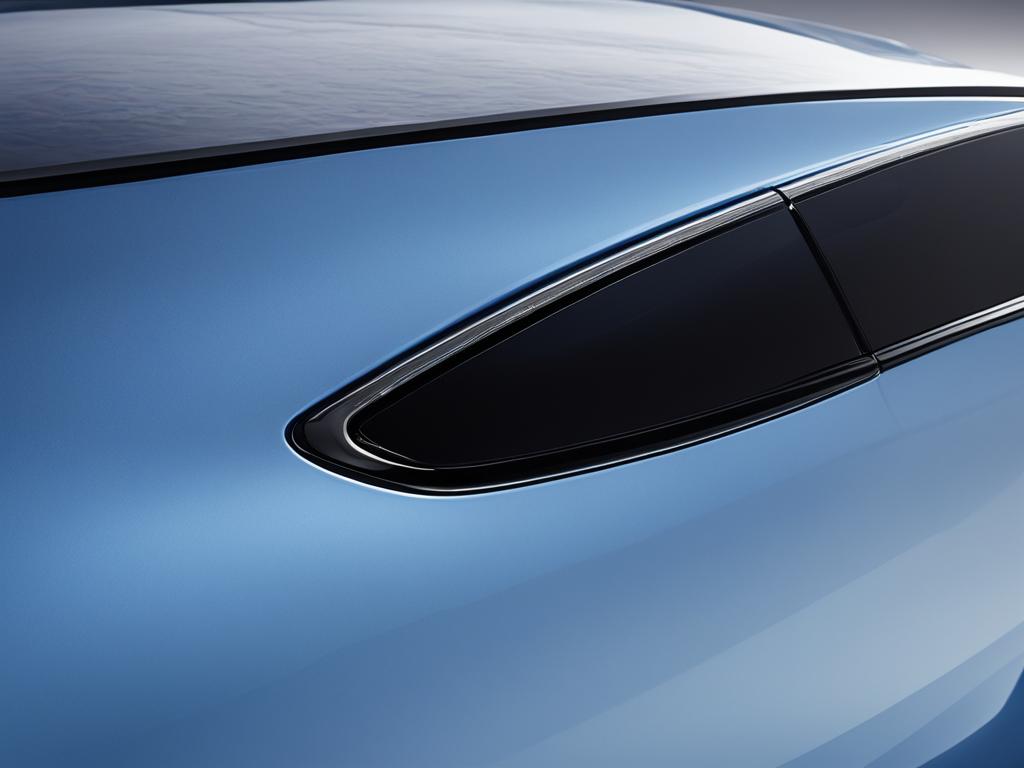
Apply Synthetic Coating for Additional Protection
To enhance the protection of your car’s exterior, consider applying synthetic coating, such as ceramic coating. This coating offers numerous benefits, including a brilliant shine, protection against UV light and chemical stains, superior scratch resistance, water resistance, and exceptional durability. Whether you choose a professional installation or opt for a DIY approach, synthetic coating is a highly effective solution for long-lasting car paint protection.
When applied correctly, synthetic coating provides a glossy finish that enhances the overall appearance of your vehicle. It creates a protective barrier against harmful UV rays, preventing paint fading and degradation caused by prolonged sun exposure. Additionally, it acts as a shield against chemical stains, ensuring that your car’s paint remains resistant to harsh substances like bird droppings, tree sap, and road tar.
One of the significant advantages of synthetic coating is its outstanding scratch resistance. It forms a durable layer on the car’s surface, protecting it from minor scratches and swirl marks that can occur during regular use. This coating also offers excellent water resistance, helping to repel water and prevent damage caused by water spots and mineral deposits.
Ceramic coating, in particular, undergoes a chemical bonding process with the car’s paint, creating an incredibly strong and long-lasting bond. This ensures that the coating remains intact for an extended period, typically several years, even with regular exposure to environmental factors.
Professional Installation for Optimal Results
While DIY ceramic coating kits are available, professional installation is recommended for optimal results. Professional installers have the expertise and knowledge to prepare the car’s surface properly and apply the coating evenly, ensuring maximum protection and a flawless finish.
During the installation process, the car’s surface is thoroughly cleaned and decontaminated to remove any dirt, grime, or existing waxes. This step is crucial to achieve proper bonding of the coating. The professional installer then applies the synthetic coating using professional-grade equipment and techniques to ensure a smooth and uniform finish.
Professional installation not only guarantees superior results but also saves you time and effort. With their experience and expertise, professional installers can complete the process efficiently, allowing you to enjoy the benefits of synthetic coating without the hassle of a DIY approach.
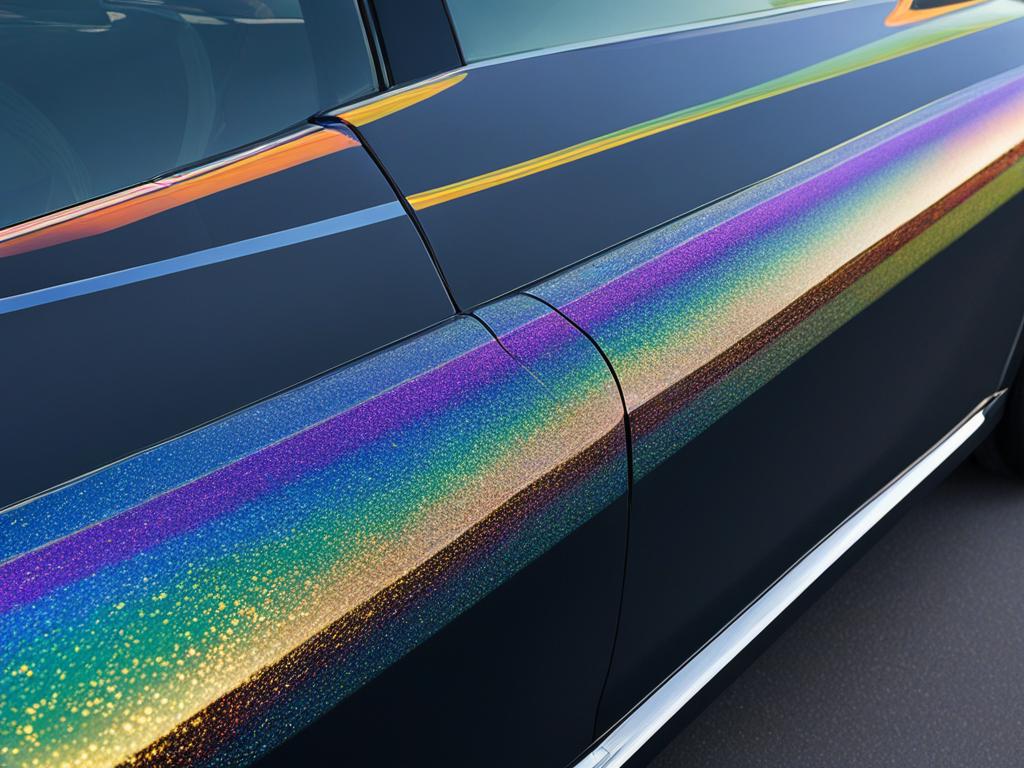
In summary, synthetic coating, such as ceramic coating, offers a brilliant shine, protection against UV light and chemical stains, superior scratch resistance, water resistance, and exceptional durability. It is an excellent investment for car owners who want to maintain the pristine condition of their vehicles. Consider professional installation for optimal results, or choose a DIY option with proper prep work and high-quality products.
Conclusion
Proper car seal protection and maintenance are crucial for prolonging the life of car seals and safeguarding the vehicle’s exterior. Regular washing and waxing, along with selecting the appropriate sealant or coating, are the keys to maintaining the shine and integrity of the car’s paint. Following a car maintenance schedule and conducting check-ups ensure optimal vehicle performance and minimize the risk of expensive repairs.
By prioritizing car seal protection, you can shield your car’s exterior from the damaging effects of UV rays, environmental elements, and contaminants. Investing in quality car sealants, such as Nexgen Ceramic Coating Spray, Meguiar’s Mirror Glaze Synthetic Sealant, CARPRO Reload Spray Sealant, or Chemical Guys JetSeal Anti-Corrosion Sealant, can provide long-lasting protection and enhance the overall appearance of your vehicle.
Remember to regularly wash and wax your car, choose the right sealant or coating based on your vehicle’s needs, and follow a comprehensive maintenance schedule. By taking these measures, you can safeguard your car seals, protect the exterior, and enjoy a well-maintained vehicle that retains its value over time.
FAQ
What is car sealant?
Car sealant, also known as car paint sealant, is a synthetic product that protects a vehicle’s exterior and paint from UV rays, heat, and acid rain. It provides a glossy shine, protects the paint from contaminants, and requires minimal maintenance.
What are the types of sealants for cars?
There are different types of sealants for cars, with acrylic and polymer sealants being the most common. Acrylic sealants provide a glossy finish and are easy to apply. Polymer sealants offer longer-lasting protection and are resistant to scratches, swirls, and high temperatures. Some popular sealants include Nexgen Ceramic Coating Spray, Meguiar’s Mirror Glaze Synthetic Sealant, CARPRO Reload Spray Sealant, and Chemical Guys JetSeal Paint Sealant.
How do I choose the right sealant for my car?
When choosing a sealant for your car, consider factors such as the material of your vehicle, your budget, and your specific objective. Different sealants may work better on certain vehicles or provide specific benefits like protection against rain or UV light. It is important to read the ingredients and follow the manufacturer’s recommendations for application.
What are some preventative tasks for car maintenance?
Regular car maintenance is important for optimal vehicle performance and longevity. Preventative tasks include checking oil and coolant levels, inspecting the air filter, monitoring tire pressure and tread depth, ensuring proper functioning of lights, changing oil and filters, rotating tires, waxing the vehicle, checking transmission fluid, inspecting shocks and struts, coolant fluid exchange, checking spark plugs, and inspecting the serpentine belt and differentials.
What are some short-term check-ups for car maintenance?
Short-term check-ups for car maintenance include regularly checking oil and coolant levels, inspecting the air filter, monitoring tire pressure and tread depth, ensuring proper functioning of headlights and lights, changing oil and filters, rotating tires for even wear, and waxing the vehicle to protect the paint and reduce the chance of rust.
What are some long-term check-ups for car maintenance?
Long-term check-ups for car maintenance involve checking and changing transmission fluid, inspecting transfer case fluid in four-wheel or all-wheel drive vehicles, inspecting shocks and struts, exchanging coolant fluid in the radiator, checking and replacing spark plugs, inspecting the serpentine belt, and maintaining the front and rear differentials. These tasks ensure the proper functioning and longevity of the vehicle.
What are some seasonal check-ups for car maintenance?
Seasonal check-ups for car maintenance include replacing windshield wipers regularly, checking battery performance, changing tires for winter driving conditions, and checking coolant levels to prevent freezing in colder months. These tasks help maintain the vehicle’s safety and performance in different weather conditions.
How should I wash and dry my car?
Regularly washing and drying your car is essential to remove dust, dirt, and grime that can damage the paint and protect against UV rays. Choose a shady spot, use a gentle automotive cleaner, and a clean cloth or microfiber towel to wash and dry your car properly. Cleaning bird droppings and mud stains should be done gently with suitable products to avoid paint damage.
How does waxing my car help?
Waxing your car improves the luster of the clear coating, provides protection against UV rays, bird droppings, and bug splatters, and reduces drag force. There are different types of car wax, including solid paste and liquid formulations, with varying levels of cleaning, protection, and polishing properties.
What are the benefits of using paint sealant?
Paint sealants provide a glossy look, are easy to use, and offer longer-lasting protection than car wax. They can protect against scratches and swirl marks but may require more prep work before application. Paint sealants can highlight imperfections and may be more resistant to environmental factors.
What is synthetic coating and how does it protect my car?
Synthetic coating, such as ceramic coating, provides a brilliant shine, protects against UV light and chemical stains, offers superior scratch resistance, and makes the car more water-resistant. It is extremely durable and can last for several years. Professional installation is recommended for optimal results, but DIY options are available with proper prep work and high-quality products.
How can I ensure the longevity of my car seals?
Proper car seal protection and maintenance are essential to prolong the life of car seals and protect the vehicle’s exterior. Regular washing, waxing, and choosing the right sealant or coating are key to maintaining the shine and integrity of the car’s paint. Following a car maintenance schedule and performing check-ups ensure optimal vehicle performance and reduce the risk of costly repairs.

